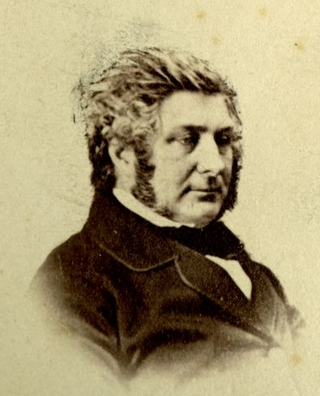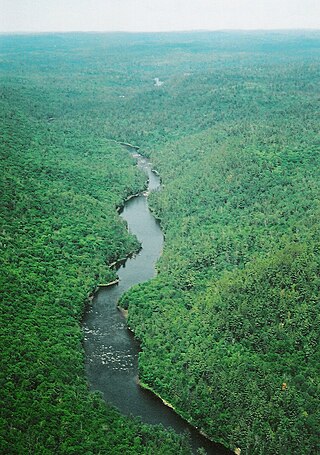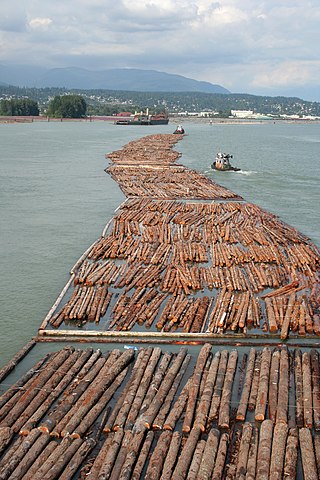
Lumberjack is a mostly North American term for workers in the logging industry who perform the initial harvesting and transport of trees. The term usually refers to loggers in the era before 1945 in the United States, when trees were felled using hand tools and dragged by oxen to rivers.

A log flume or lumber flume is a watertight flume constructed to transport lumber and logs down mountainous terrain using flowing water. Flumes replaced horse- or oxen-drawn carriages on dangerous mountain trails in the late 19th century. Logging operations preferred flumes whenever a reliable source of water was available. Flumes were cheaper to build and operate than logging railroads. They could span long distances across chasms with more lightweight trestles.

The Wisconsin River is a tributary of the Mississippi River in the U.S. state of Wisconsin. At approximately 430 miles long, it is the state's longest river. The river's name was first recorded in 1673 by Jacques Marquette as "Meskousing" from his Indian guides - most likely Miami for "river running through a red place."

Philemon Wright was a farmer, lumberman and entrepreneur who founded the Ottawa River timber trade in 1806. He was also founder of what he named Columbia Falls Village, mostly known as Wright's Town, Lower Canada and Wright's Village to others, the first permanent settlement in the National Capital Region of Canada. Wright's Town, later became incorporated in 1875 and renamed Hull, Quebec, and then in 2002, as a result of a municipal amalgamation, it acquired its present name of the City of Gatineau.
Ruggles Wright was a Canadian lumber merchant, the second youngest son of Philemon Wright.

The Bonnechere River is a river in the Saint Lawrence River drainage basin in Nipissing District and Renfrew County in eastern and northeastern Ontario, Canada. The river flows from Algonquin Provincial Park to the Ottawa River east and north of the town of Renfrew. The river's name is thought to come from the French "bonne chère" meaning "plentiful good food".

John Rudolphus Booth was a Canadian lumber tycoon and railroad baron. He controlled logging rights for large tracts of forest land in central Ontario, and built the Canada Atlantic Railway to extract his logs and to export lumber and grain to the United States and Europe. In 1892, his lumber complex was the largest operation of its kind in the world.

Admaston/Bromley is an incorporated township in Renfrew County, Eastern Ontario, Canada. It was formed on January 1, 2000, when Admaston and Bromley Townships were amalgamated. It takes part of its name from Admaston, Staffordshire, a small English hamlet.

The Chaudière Falls, also known as the Kana:tso or Akikodjiwan Falls, are a set of cascades and waterfall in the centre of the Ottawa-Gatineau metropolitan area in Canada where the Ottawa River narrows between a rocky escarpment on both sides of the river. The location is just west of the Chaudière Bridge and Booth-Eddy streets corridor, northwest of the Canadian War Museum at LeBreton Flats and adjacent to the historic industrial E. B. Eddy complex. The islands surrounding the Chaudière Falls, counter-clockwise, are Chaudière Island, Albert Island, little Coffin Island was just south of Albert Island but is now submerged, Victoria Island and Amelia Island,, Philemon Island was originally called the Peninsular Village by the Wrights but became an island when the timber slide was built in 1829 it is now fused to south shore of City of Gatineau, and Russell Island, now submerged, was at the head of the Falls before the Ring dam was built. The falls are about 60 metres (200 ft) wide and drop 15 metres (49 ft). The area around the falls was once heavily industrialized, especially in the 19th century, driving growth of the surrounding cities.

John Egan was an Irish-Canadian businessman and political figure in the Ottawa region.

The Dumoine River is a river in western Quebec with its source in Machin Lake near La Vérendrye Wildlife Reserve. From Dumoine Lake, the river flows almost due south off the Canadian Shield and empties into the Ottawa River, just west of Rapides-des-Joachims, Quebec, or Rolphton, Ontario. The river is 129 kilometres (80 mi) long and drains a watershed of 5,380 square kilometres (2,080 sq mi). This relatively short river compared to its drainage area indicates that the Dumoine has a strong current and many steep-gradient rapids.

Timber rafting is a method of transporting felled tree trunks by tying them together to make rafts, which are then drifted or pulled downriver, or across a lake or other body of water. It is arguably, after log driving, the second cheapest means of transporting felled timber. Both methods may be referred to as timber floating. The tradition of timber rafting cultivated in Austria, the Czech Republic, Germany, Latvia, Poland and Spain was inscribed on UNESCO Representative List of the Intangible Cultural Heritage of Humanity in 2022

The Coulonge River is a predominantly wilderness river in western Quebec, Canada.

Portage-du-Fort is a village municipality in the Pontiac Regional County Municipality in the southwest corner of the Outaouais region of Quebec, Canada. The village lies across the Ottawa River from Chenaux, Ontario and Horton, Ontario.

The Coulonge Chutes is a non-profit recreation park and historical exhibition area operating in Mansfield-et-Pontefract, in the Pontiac Regional County Municipality of western Quebec, Canada. Its main attraction is the 42 meters (138 ft) high Grandes Chutes waterfall of the Coulonge River and 100 meters (330 ft) long cement log slide.
The history of Ottawa, capital of Canada, was shaped by events such as the construction of the Rideau Canal, the lumber industry, the choice of Ottawa as the location of Canada's capital, as well as American and European influences and interactions. By 1914, Ottawa's population had surpassed 100,000 and today it is the capital of a G7 country whose metropolitan population exceeds one million.

Dog-hole ports were the small, rural ports on the West Coast of the United States between Central California and Southern Oregon that operated between the mid-1800s until the 1930s. They were commonly called dog-holes because the schooners that served them would have to be able to "turn around in a harbor barely small enough for a dog".

The Ottawa River timber trade, also known as the Ottawa Valley timber trade or Ottawa River lumber trade, was the nineteenth century production of wood products by Canada on areas of the Ottawa River and the regions of the Ottawa Valley and western Quebec, destined for British and American markets. It was the major industry of the historical colonies of Upper Canada and Lower Canada and it created an entrepreneur known as a lumber baron. The trade in squared timber and later sawed lumber led to population growth and prosperity to communities in the Ottawa Valley, especially the city of Bytown. The product was chiefly red and white pine.The Ottawa River being conveniently located with access via the St. Lawrence River, was a valuable region due to its great pine forests surpassing any others nearby. The industry lasted until around 1900 as both markets and supplies decreased, it was then reoriented to the production of wood pulp which continued until the late 1990s and early 2000s.

The recorded history of Grand Rapids in the U.S. state of Michigan, began with settlers in 1806.
The Gilmour Lumber Company was one of the giants of the Canadian timber industry. Their involvement in lumbering began modestly in the 1790s in the area of Glasgow, Scotland where Allan Gilmour Sr. started a small timber merchandising business. In 1804 he entered into a partnership with his cousins John and Arthur and formed Pollock, Gilmour and Company. Pollock, Gilmour and Company became ship owners and imported products in Europe and the Baltic region.

















